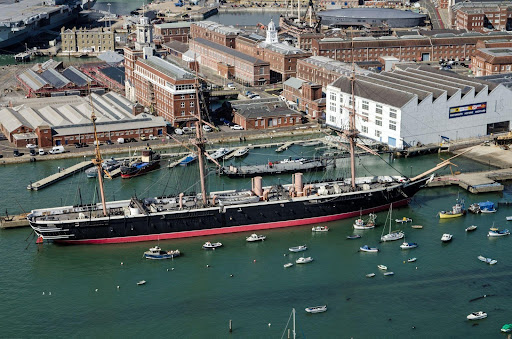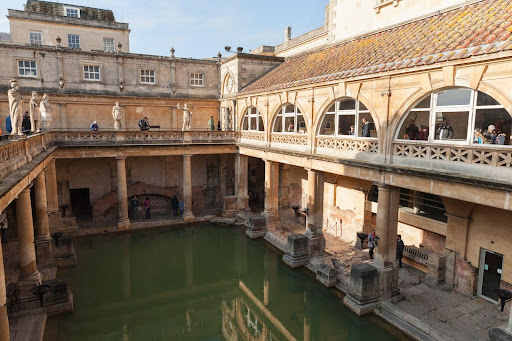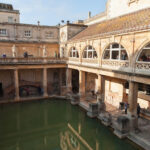The UK’s landscape is rich with historical landmarks, each telling its own unique story. From ancient monuments to preserved buildings, the nation takes pride in safeguarding its architectural heritage and cultural past.
Laws from as early as 1944 and 1953 laid down frameworks for the conservation of historic places, ensuring that these treasures could stand the test of time. This commitment has seen several sites gain recognition on the World Heritage List, celebrating their significance not just to Britain but to humanity as a whole.
Amongst these cherished spaces are castles, baths, docks, and even entire landscapes that have played pivotal roles throughout history.
Tourists and locals alike find endless fascination within these walls and ruins. Whether it’s walking through an age-old castle or exploring a prehistoric village, there’s a sense of connection to those who walked before us.
The National Heritage List for England, alongside Grade 2 listings, serve as guides into this past world — pointing out buildings of special interest scattered across the country. For family outings or solo adventures seeking depth beyond mere sightseeing, Britain’s extensive selection of heritage sites offers something timeless—echoes of eras gone by waiting to be rediscovered anew at every visit.

Portsmouth Historic Dockyard
Let’s explore Portsmouth Historic Dockyard. It is an important place that shows Britain’s naval history. You can see three famous ships there: HMS Victory, HMS Warrior, and Mary Rose. These ships have fought many battles and won many victories.
The National Museum of the Royal Navy is also at the dockyard. You can learn a lot about naval history there. The old buildings and boathouses at the dockyard are very charming. It is a great place to visit if you want to learn about Britain’s seafaring past.
The Mary Rose Trust is also located at the dockyard. It tells stories from many centuries ago. You can learn about maritime history in this place, which has stood for a long time.
According to ALVA figures, Portsmouth Historic Dockyard is one of the top forty visitor attractions in the UK for three years in a row. It is not just about ships but a journey through time in one of Britain’s most important naval places.
Roman Baths, Bath
The Roman Baths in Bath, England, are a great example of Roman architecture and engineering. They were built around 70 CE over hot springs. The baths were a place for socializing and relaxing in Roman Britain.
Imagine large pools with hot water and rooms for changing clothes, toilets, and hot and cold baths. It was very fancy at that time! The baths were not just for leisure; they were also a religious spa where people performed ancient rituals.
The old Roman Baths site gives a look at many objects found before and during Roman times. These treasures show what life was like long ago in this part of Northern Europe.
People are amazed that these structures are so well-preserved. The Roman Baths are one of the best remaining examples of ancient sites from the Roman Empire.
Photo 183407321 © Alberto Zamorano
The Hippodrome London
An old theater in Westminster first opened in 1900, it was a big hall where famous musicians performed. In 2012, it became a casin0. The Mayor of London made this big change. In 2013, people said it was the best casino. This showed its great design and things to do.
The casin0 can have up to 2000 people, so it’s a good place for large events. It is famous for its poker rooms, and people come from all over to play poker there. The casin0 looks like an old theater with modern luxury. It is like medieval castles. They had strong defenses but were also grand.
Today, people visit for gambling and its history. It shows how London’s culture changed over time, and how its musical past mixes with modern gambling. This creates an exciting place. It has the power and prestige of places like Caernarfon Castle.
Photo 113484882 © Denis Kelly
Ironbridge Gorge, Shropshire
Ironbridge Gorge in Shropshire is an important place. Beginning in the 1700s, big changes were sparked here. The Iron Bridge over the River Severn was the world’s first bridge made of cast iron in 1781.
This bridge wasn’t just the first, it showed what British industry was capable of and helped push technology and engineering forward.
In 1986, UNESCO made Ironbridge Gorge a World Heritage Site. With its museums in this special area- just a few miles from Telford Town Centre, it’s more than a bridge. It shows how innovation and change spread through British industry.
Photo 206056401 © Pepperboxdesign
Corfe Castle, Dorset
Moving from the industrial wonders of Ironbridge Gorge, we go to an ancient place. Corfe Castle ruins in Dorset show medieval power. Its crumbling walls stand over the village below.
Built after the Norman conquest in 1066, this strong castle played many roles over its thousand-year history. It sits above the village with the same name on the Isle of Purbeck peninsula. Corfe Castle’s story is about changes in buildings and big events in England after medieval times.
Detailed records from the 1000s show life during war and peace. It’s not just an old ruin. It tells the story of survival through changing times and power struggles that shaped Dorset and beyond.
Edinburgh Castle, Scotland
Edinburgh Castle sits on top of an extinct volcano. It towers over the city like a guard watching over history. The castle’s walls have stood since the Iron Age. It is one of Europe’s oldest and most famous fortresses.
This castle has seen everything – royal parties and dark times as a prison for warriors. The Crown Jewels shine inside, showing visitors Scotland’s rich heritage.
Walking through the Great Hall feels like traveling back in time. It is filled with stories of heroes and legends who once walked the halls. More than its military power and royal beauty, Edinburgh Castle symbolizes strength. It has withstood centuries of change.
Bletchley Park, Milton Keynes
After leaving the historic Edinburgh Castle, the journey through UK history continues. It leads to Bletchley Park in Milton Keynes. This English country house kept secrets during World War Two.
Brilliant minds like Alan Turing worked here, cracking codes to help the Allied forces. This was not just any estate, it was where modern computing began.
Now open to all, Bletchley Park honors innovation and courage. Visitors can see where Turing’s team decoded enemy messages using the Bombe machine, an invention that changed history.
This Buckinghamshire site isn’t just a piece of heritage; it’s where war heroes used intelligence and creativity to shape the future.
Photo 158665240 © Oksanaphoto
Skara Brae, Orkney
Skara Brae, Orkney, is a hidden gem on the Orkney Islands, far off Scotland’s north coast. This ancient village dates back to around 5,000 years ago. That’s even older than Stonehenge and the pyramids in Egypt! People are often amazed by how well Skara Brae has stood the test of time.
This prehistoric settlement gives us a rare peek into life during the Stone Age. It shows us neat stone houses that were home to farmers and fishermen who lived there long ago.
This site isn’t just old rocks, it’s a UNESCO World Heritage Site proudly showing off Scottish history from the Neolithic era. Imagine walking through one of Europe’s most perfectly preserved Stone Age villages, that’s what visiting Skara Brae feels like.
Its clever design and historical depth make it a treasure trove for anyone keen on archaeology or ancient architecture.
Photo 171984809 © Travelling-light
Avebury Henge and Stone Circles, Wiltshire
Leaving behind the ancient homes of Orkney, travelers find themselves in the mystical presence of Avebury Henge and Stone Circles. This Neolithic henge monument boasts three stone circles that have stood tall from about 2850 BC to 2200 BC.
It’s not just any old circle of stones; this is the largest stone circle in Britain and a proud UNESCO World Heritage Site.
People come to Wiltshire from all over to see Avebury Stone Circles, a historic site unlike any other. Its huge stones share stories as old as time itself, inviting visitors into a world where history feels alive under their feet.
Photo 122584181 © Michael Schroeder
Hadrian’s Wall, England and Scotland
Hadrian’s Wall stretches across northern England, from the west coast to the east. Soldiers from Britain’s three legions built this massive wall and auxiliary troops manned it.
It’s not just old stones, it’s a UNESCO World Heritage Site that represents over 300 years of Roman frontier history. The Wall was part of a defense system, a giant ditch and stone or turf barriers kept invaders out.
This ancient monument connects England and Scotland in an unexpected way—it doesn’t mark their current border. Instead, Hadrian’s Wall shows the power of the Roman Empire. It shows their military engineering skills.
People come here to walk along parts of the wall still standing against the landscape. They imagine life as a Roman soldier on this distant frontier. It captures imagination and curiosity and offers glimpses into an ancient past where Rome reached deep into British lands.
Conclusion
Living spaces and culture come together at the UK’s historic sites. They’re not just old stones and faded paintings. They’re vibrant parts of neighborhoods, stirring curiosity in everyone who visits.
Protecting historic places is an important task. It involves repairing them and ensuring they are not damaged or forgotten. The goal is to preserve stories for future generations to experience history firsthand. Places like Canterbury Cathedral captivate visitors from around the world. They inspire people to learn more and provide insight into how people lived, worked, and played in the past.










